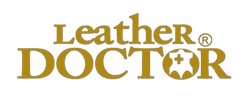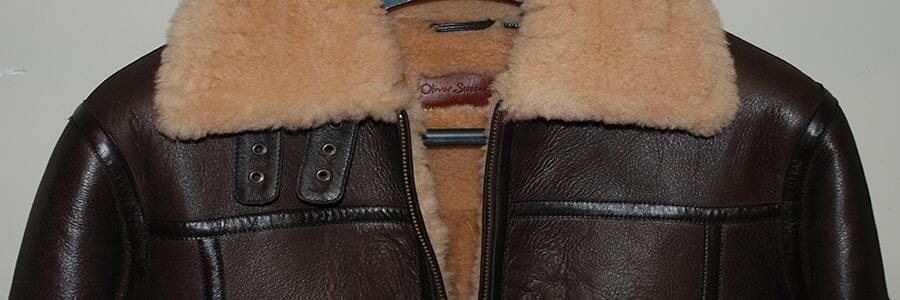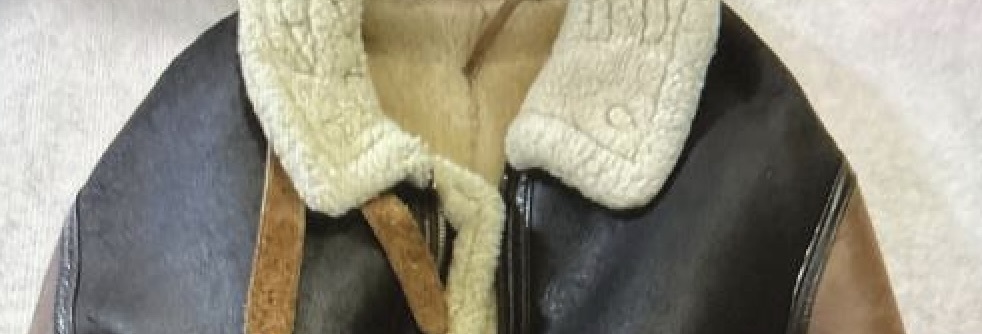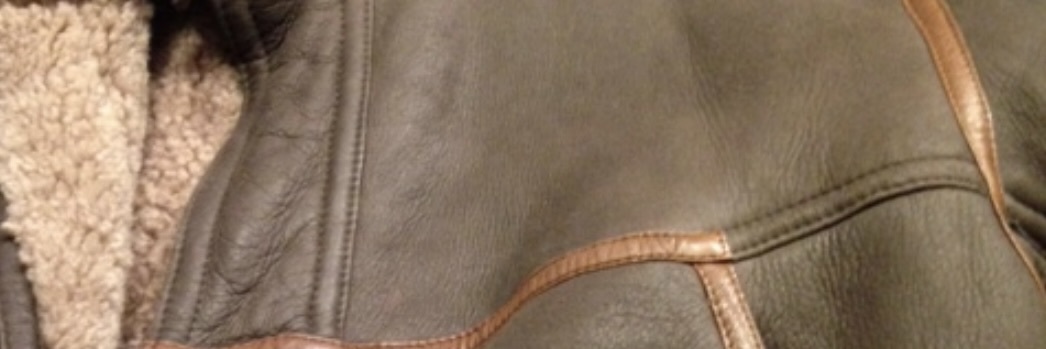Shearling Nappalan Cleaner and Conditioner Kit SN4 by Leather Doctor cleans, rinses, hydrates, softens, and conditions the outer leather and the inner wool face.
What is Nappalan Shearling?
-
Nappalan Shearling is a sheepskin with a suede outer surface coated for a smooth finish on the outside as the inner face consists of sheared wool for warmth and comfort.
-
It is available in both glossy and waxy-matte finishes.
-
However, sun fading is a common issue due to aniline dyes.
-
Over time, abrasion or wear may expose the underlying suede.
Signs of Premature Aging in Nappalan Shearling:
- Premature aging is most noticeable in folds and creases, or when sleeves appear shorter than their original length.
Reviving Nappalan from Premature Aging:
- Aging effects can be reversed by hydration and fatliquoring, which:
- Restore flexibility and suppleness
- Smooth out creases and wrinkles
- Replenish essential oils to prevent stiffness and brittleness
Why Hydration?
- Hydration plays a critical role in restoring shearling by:
- Relaxing creases and wrinkles
- Improving flexibility and elasticity
- Creating an optimal condition for fatliquoring
Preventing Sleeve Shrinkage:
- Shearling sleeves may appear shorter over time due to natural creasing and the loss of essential fats and oils.
- Hydrating and fatliquoring help restore elasticity, allowing the sleeves to regain their original length.
- Regular fatliquoring prevents shrinkage by maintaining the leather’s moisture balance.
Reducing Friction Wear on Nappalan Finishes:
- Friction wear is a common issue, especially in areas where leather rubs against itself, such as with swinging arm movements.
- To minimize friction wear, apply:
- Protector B for a glossy finishes
- Protector W for a soft waxy matte finishes
Why Leather Becomes Stiff and Prone to Tearing:
- Leather can become stiff, brittle, and prone to tearing due to:
- Evaporation of natural fats and oils over time, accelerated by heat exposure
- Water damage and alkalinity toxicity, which leach out essential oils, weakening the material
Recommended Cleaning Sequence for Nappalan Shearling:
- For best results, follow this cleaning sequence:
- Start with the wool with Wool 5.5 and Rinse 4.0, and allow to dry before cleaning the Nappalan.
- Proceed with Cleaner 3.8, Rinse 3.0, Hydrator 3.3, and Fatliquor 5.0 on the Nappalan, and let dry before conditioning.
- Wool side conditioning first, let dry before finish conditioning the Nappalan.
With regular care using Kit SN4, your shearling will maintain its fresh appearance, prevent wrinkles and premature wear, and keep the wool face clean, soft, and full of life.
This SN4 kit contains concentrated products that require dilution with 1.9 quarts (1732g) of distilled water before use.
Included Products in Kit SN4
- Wool 5.5
- Rinse 4.0
- Conditioner S
- Soft 3.8
- Rinse 3.0
- Hydrator 3.3
- Fatliquor 5.0
- Protector B
- Brush 1
- Brush 4
- Foam 2
- Towel 5
Wool 5.5 is a wool-safe disinfectant cleaner designed to clean, deodorize, and refresh wool skin, sheepskin, and shearling while reducing wool odors during drying.
Key Features:
- Wool-Safe Formula – Maintains the integrity of delicate wool fibers
- pH 5.5 Balanced – Gentle and effective for all wool types
- Water-Based – Penetrates and lifts dirt without harsh chemicals
- Deodorizing Action – Reduces odors for a fresher finish
- Safe for Multiple Materials – Suitable for wool, feather, hair-on-hide, and most fabrics (except rayon and silk)
How It Works:
- Wool 5.5 works by penetrating, lubricating, and suspending soiling through a chemical reaction, ensuring deep yet gentle cleaning without damaging the fibers.
- It is ideal for regular maintenance as well as deep cleaning of wool-based items.
- This product is a must-have for preserving the softness, freshness, and longevity of sheepskin and wool-based items.
Rinse 4.0 is a pH 4.0 wool-safe rinse designed to remove suspended soiling, balance pH levels, and restore a healthy, squeaky feel to wool skin, shearling, and sheepskin.
Key Benefits:
- Rinses & Removes Residue – Effectively lifts and clears soiling after cleaning
- pH Balancing – Neutralizes and stabilizes the wool’s pH chemistry integrity
- Strengthens Wool Fibers – Enhances fiber resilience after drying
- Restores Natural Softness – Leaves a fresh, clean, and soft finish
How It Works:
- Rinse 4.0 is recommended as a final rinse after cleaning with Wool 5.5.
- It helps maintain the wool’s natural structure by ensuring proper pH balance, preventing brittleness, and keeping the wool soft, healthy, and long-lasting.
Conditioner S is a non-stick, rub-resistant, soft, and silky conditioner designed to protect and enhance the resilience of shearling wool, sheepskin, and woolskin.
Key Benefits:
- Prevents Rubbing Breakage – Strengthens wool fibers to resist friction damage
- Softens & Enhances Silkiness – Maintains a luxurious, plush texture
- Non-Film-Forming & Breathable – Preserves the wool’s natural breathability
- Shields Against Sticky Soiling – Reduces attraction of dirt and contaminants
How It Works:
- Conditioner S forms a protective barrier without leaving a residue, ensuring that the wool remains soft, flexible, and resistant to matting.
- It is an essential final step in the care routine for shearling and sheepskin to maintain optimal texture and durability.
Soft 3.8 is a leather-safe, pH 3.8 mild cleaner formulated to effectively emulsify and lift general soiling without causing common side effects.
Key Benefits:
- Gently Cleans Without Harsh Effects – Maintains leather’s natural integrity
- Works Seamlessly with Prep 4.4 – Allows for after-cleaning of sticky residue
- Prevents Rings & Browning – Ideal for pH-sensitive leathers
- Residue-Free with Rinse 3.0 – Restores leather’s pH balance for long-term care
How It Works:
- Soft 3.8 is designed to break down and suspend dirt for easy removal while keeping the leather's structure intact.
- When followed by Rinse 3.0, it ensures a neutralized, residue-free finish, preventing unwanted side effects such as stiffness, discoloration, or over-drying.
- This makes it especially beneficial for aniline and other delicate leather types.
Leather Rinse 3.0
Rinse 3.0 is a pH 3.0 rinse formulated to remove suspended soil and restore leather’s pH balance, ensuring long-term structural integrity.
Key Benefits:
- Neutralizes Alkaline Residues – Prevents damage from harsh cleaning agents
- Restores pH Balance – Keeps leather soft, supple, and structurally sound
- Prevents Tackiness & Dye Bleeding – Maintains the original look and feel of the leather
- Enhances Bonding of Leather Constituents – Strengthens the leather’s natural structure
How It Works:
- Rinse 3.0 works by lifting and extracting suspended soiling with a towel while neutralizing harmful alkaline residues left behind from cleaning.
- It also recharges the leather with a positive (+ve) ionic charge, improving its ability to bind with negatively (-ve) charged tanning agents, dyestuff, and fatliquor.
- This process prevents tackiness, dye loss, and stiffness, ensuring the leather remains soft, durable, and resistant to future damage.
Hydrator 3.3 is a pH 3.3 hydrating conditioner designed to relax, soften, and restore leather’s natural integrity while preparing it for fatliquoring.
Key Benefits:
- Restores Leather Softness & Flexibility – Relaxes stiff fibers and prevents brittleness
- Smooths Out Creases & Wrinkles – Prepares leather for optimal conditioning
- Reactivates Dormant Dyestuff – Helps resurface color for a more even appearance
- Prepares for Fatliquoring – Enhances absorption of essential oils and fats
- Residue-Free & Non-Sticky – Ensures a clean, breathable finish
How It Works:
- Hydrator 3.3 penetrates deep into the leather, reducing surface tension and allowing for colloidal water movement to reactivate dyes and even out color inconsistencies.
- It plumps the leather structure, making it more receptive to fatliquoring with Fatliquor 5.0, which restores essential oils for long-term suppleness and durability.
- Hydrator 3.3 is an essential step in rejuvenating aged, dry, or stiff leather, ensuring lasting flexibility, color vibrancy, and overall leather health.
Fatliquor 5.0 is a pH 5.0 micro-emulsion of fat, oil, and water, designed to restore leather’s original softness, strength, and flexibility.
How It Works:
- Replenishes Essential Fats & Oils – Prevents leather from drying, stiffening, or cracking
- Enhances Leather’s Suppleness & Elasticity – Maintains a soft, luxurious feel
- Strengthens Leather Fibers – Improves tensile strength and durability
- Creates a Breathable Structure – Ensures leather remains pliable without feeling greasy
- Prevents Brittleness & Fiber Breakage – Essential for long-term leather preservation
Application Process:
- When applied, the water-encased fat and oil molecules penetrate deep into the leather fibers.
- As the water gradually evaporates, the fat and oil molecules hydrogen bond with the fibers, creating a breathable, flexible structure that enhances leather’s resilience and longevity.
- Proper fatliquoring ensures that leather retains its tensile strength, resists breakage, and maintains its natural softness, preventing premature aging, dry rotting, and deterioration.
- Protector W is a matte, soft, waxy-feel, non-stick, rub-resistant conditioner designed to enhance and protect leather while maintaining a refined, natural appearance.
Features & Benefits:
- Matte, Waxy-Feel Conditioning – Provides a soft, luxurious touch without an artificial gloss
- Non-Stick Formula – Shields against sticky soiling and prevents dirt buildup
- Rub-Resistant Protection – Reduces friction wear, scuffing, and stretching for extended leather durability
- Refined Appearance – Enhances the leather’s natural beauty with a finer, non-glossy finish
- Offers the same benefits as Protector W, but with an added luxurious leather scent
Ideal For:
- Waxy-Matte Leather – Maintains a natural, sophisticated look
- Steering Wheels, Split-Suede & Waxed Aniline Leather – Protects against daily wear and tear while preserving the leather’s integrity
Protector W keeps leather feeling soft, looking elegant, and protected from everyday stress without the cheap gloss look.
Brush 1 is a detailing horsehair brush designed for gentle, scratch-free cleaning on all smooth and Nappalan leathers.
- Soft Horsehair Bristles – Ensures safe cleaning without scratching or damaging leather surfaces
- Ergonomic Grooved Grip – Provides comfort and control for effortless detailing
- Sturdy & Durable Design – Built for long-term use in leather maintenance
- Ideal for Deep Pore Cleaning – Effectively loosens embedded dirt and grime without harming the finish
Brush 4 is a detailing steel brush designed for brushing and grooming the wool face of sheepskin and shearling to restore its natural loft and softness.
- Fine Steel Bristles – Gently lifts and fluffs wool fibers for a refreshed, plush appearance
- Ergonomic Grooved Grip – Provides comfort and control for effortless grooming
- Durable & Sturdy Design – Built for long-term use in sheepskin and shearling care
- Restores Wool Texture – Helps maintain the natural spring and softness of wool
Foam 2 is a 2-inch high-density polyfoam brush designed for the durable, precise, and smooth application of leather care products.
- High-Density Polyfoam – Resists tearing and shredding for long-lasting use
- Even Product Distribution – Ensures smooth, streak-free application
- Controlled Absorption – Holds and releases product efficiently for optimal coverage
- Versatile Use – Ideal for applying dyes, finishes, and conditioners on leather and suede
Towel 5 is a high-performance, lint-free paper towel designed to perform like cloth for efficient cleaning and drying without leaving residues
- Lint-Free – Leaves no fibers or residues behind
- Highly Absorbent – Quickly absorbed suspended soiling
- Stretchable & Durable – Strong enough for repeated use without tearing
- Washable & Reusable – Can be rinsed and reused for multiple applications
Wool Cleaning, Rinsing, and Conditioning Instructions:
1 Cleaning
- Start by brushing off dry soil with Brush 4. For best results, vacuum the area to remove any additional particles. Afterward, proceed with wet cleaning.
- Wool 5.5 concentrate (1: 64) is mixed with 224g distilled water or filling 1.5 inches from the top of an 8oz bottle.
- Apply and gently brush in one direction at a low slanting angle. Use Towel 5 to extract the soiling until the towel is clean. Once cleaned, proceed to the rinsing step.
2 Rinsing
- Rinse 3.0 concentrate (1: 40) is mixed with 222g distilled water or 1.5 inches from the top of an 8oz bottle.
- Apply and brush in one direction at a low slanting angle, and extract with Towel 5 until the towel is clean and the wool feels squeaky healthy. Allow the wool to dry naturally. During the drying process use a dry towel to wipe off any residual soiling. Once dry, move on to conditioning.
3 Conditioning
- Conditioner S concentrate (1: 19) is mixed with 217g distilled water or 1.5 inches from the top of an 8oz bottle.
- Apply and brush evenly to distribute the product deeply into the wool. Allow it to dry completely.
- Once dry, groom the wool with a slicker comb for a polished "bloom" effect and the best appearance.
Nappalan Cleaning, Rinsing, Hydrating, Fatliquoring, and Conditioning Instructions:
1 Cleaning
- Begin by brushing off dry soil with Brush 1. Use a clean, dry towel to extract any remaining particles until the towel shows clean.
- Cleaner 3.8 concentrate (1: 64) is mixed with 224g distilled water, or fill 1.5 inches from the top of an 8oz bottle.
- Apply and brush with Brush 1, then use a towel to extract the soiling until the towel is clean. Proceed to the rinsing step.
2 Rinsing
- Rinse 3.0 concentrate (1: 40) is mixed with 222g distilled water, or fill 1.5 inches from the top of an 8oz bottle.
- Apply, brush, and extract with a towel until it shows clean and feels squeaky healthy. Once clean, begin the hydrating phase.
3 Hydrating
- Hydrator 3.3 concentrate (1: 25) is mixed with 218g distilled water, or fill 1.5 inches from the top of an 8oz bottle.
- Apply and brush to hydrate the full thickness of the leather. While still damp, massage out creases and wrinkles, stretching the leather back to its original dimension. Proceed to fatliquoring.
4 Fatliquoring
- Fatliquor 5.0 concentrate (1: 5) is mixed with 189g distilled water, or fill 1.5 inches from the top of an 8oz bottle.
- Apply, brushing, and follow the same path as the Hydrator 3.3.
- Repeat application as the water content evaporates during drying.
- Once fully saturated with fat and oil, allow the leather to dry naturally and slowly.
- Stretch and massage the creases and wrinkles as they dry to enhance suppleness. After drying, proceed to the conditioning phase.
5 Conditioning
- Protector B concentrate (1: 19) is mixed with 217g distilled water, or fill 1.5 inches from the top of an 8oz bottle.
- Apply evenly, then wipe off any excess. Allow it to dry completely before use.
6 Tips
- For an improved appearance free from creases and wrinkles, use a low-heat wool setting on an iron.
- Place a white absorbent paper between the leather and the iron, and iron using the wool setting to restore a smooth appearance.
Your opinions and insights are precious and will help us solve your leather problem more efficiently.
Updated: March 17, 2025, by Roger Koh.
1 Review Hide Reviews Show Reviews
-
The Lazarus Effect
This product revived my 40-year-old Sheepskin coat that cracked at the touch after applying another company's 'Restoration' product. That other product ruined my coat, and I was about to throw it away, but took a chance on the Leather Doctor. After applying Hydrator 3.3, I saw an immediate change. I then continued with the Fatliquor 5.0 and was shocked to see the change. My coat is now as soft and supple as it was when I purchased it in 1975! Don't even take a chance on valuable leathers with other companies' products, this one will amaze you with its results.




















